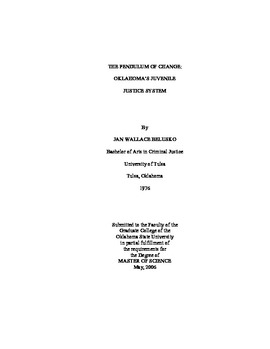| dc.contributor.advisor | Caniglia, Beth Schaefer | |
| dc.contributor.author | Belusko, Jan Wallace | |
| dc.date.accessioned | 2014-04-15T22:24:14Z | |
| dc.date.available | 2014-04-15T22:24:14Z | |
| dc.date.issued | 2006-05-01 | |
| dc.identifier.uri | https://hdl.handle.net/11244/9476 | |
| dc.description.abstract | The purpose of this study was to provide an historical summary of the development of the juvenile justice system in Oklahoma and to determine if the system was a "crime control model" or "due process model." The methodology was a qualitative intrinsic case study and primary and secondary content analysis. It was determined that the Oklahoma Juvenile Justice System is at times both "crime control and due process models" with more emphasis on the "due process model" or treatment approach. The parts of the system which were considered "crime control model" were the detention centers and the state institutions and the "due process model" or treatment approach were the community-based residential services and the local community resources. | |
| dc.format | application/pdf | |
| dc.language | en_US | |
| dc.publisher | Oklahoma State University | |
| dc.rights | Copyright is held by the author who has granted the Oklahoma State University Library the non-exclusive right to share this material in its institutional repository. Contact Digital Library Services at lib-dls@okstate.edu or 405-744-9161 for the permission policy on the use, reproduction or distribution of this material. | |
| dc.title | Pendululm of Change: Oklahoma's Juvenile Justice | |
| dc.type | text | |
| dc.contributor.committeeMember | Webb, Gary | |
| dc.contributor.committeeMember | Thrasher, Ronald R. | |
| osu.filename | Belusko_okstate_0664M_1755.pdf | |
| osu.college | Arts and Sciences | |
| osu.accesstype | Open Access | |
| dc.description.department | Department of Sociology | |
| dc.type.genre | Thesis | |
